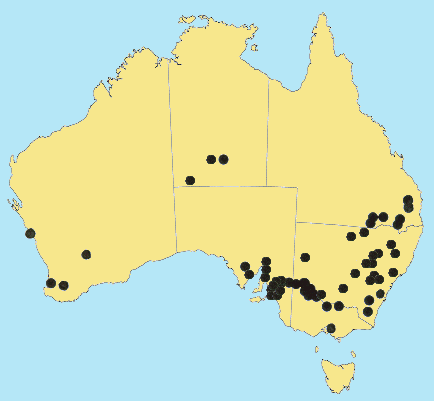Cenchrus longispinus* (Hackel)
Fernald. Rhodora 45: 388 (1943).
Classification. (GPWG 2001) : Subfamily Panicoideae.
Paniceae.
Basionym and/or
Replacement Name: C. pauciflorus
var. longispinus Hack., Allg. Bot. Z. Syst. 9: 169 (1903).
Type of Basionym or
Protologue Information: LT: Kneucker 426 [ = Harger 426], 13 Aug
1902, USA: Connecticut: Oxford (ISC-227735; ILT: US-557281). LT designated by
DeLisle, Iowa St. J. Sci. 37: 298 (1963).
Recent synonyms:
C. tribuloides auct.
Key references
(books and floras): [1952] C.A.Gardner, Flora of Western Australia 1
Gramineae (288 as C. tribuloides), [2002] D.Sharp & B.K.Simon,
AusGrass, Grasses of Australia, [2006] J.Jessop, G.R.M.Dashorst,
F.M.James, Grasses of South Australia (435), [2008] S.W.L.Jacobs,
R.D.B.Walley & D.J.B.Wheeler, Grasses of New South Wales (180).
Illustrations:
[1952] C.A.Gardner, Flora of Western Australia 1 Gramineae (289,
Pl.84 as C. tribuloides), [2006] J.Jessop, G.R.M.Dashorst, F.M.James, Grasses
of South Australia (435, Fig. 365),
[2008] S.W.L.Jacobs, R.D.B.Whalley & D.J.B.Wheeler, Grasses of New South
Wales, 4th edn (180).
Habit. Annual.
Rhizomes absent. Stolons absent. Culms geniculately ascending or decumbent,
9–90 cm tall. Ligule a fringe of hairs, 0.6–1.7 mm long. Leaf-blades 6.3–18.7
cm long, 3–7.2 mm wide. Leaf-blade surface glabrous or indumented.
Inflorescence.
Inflorescence solid, of only a few spikelets (spicate). Panicle linear, dense
(internodes 2–5mm), 4.1–10.2 cm long, 1.2–2.2 cm wide. Racemes 4.1–10.2 cm
long, 1.2–2 mm wide.
Spikelets.
Spikelets sessile, 2–3 in the cluster. Involucre composed of bristles, connate
into a cup below. Fertile spikelets 2-flowered, the lower floret barren (rarely
male), the upper fertile, comprising 1 basal sterile florets, comprising 1
fertile floret(s), without rachilla extension, ovate, dorsally compressed,
6–7.8 mm long.
Glumes. Glumes
thinner than fertile lemma. Lower glume ovate, membranous, without keels, 1
-nerved. Upper glume ovate, 4.4–6 mm long, membranous, without keels, 3–5
-nerved. Florets. Basal sterile florets 1, barren, with palea. Lemma of
lower sterile floret 80 % of length of spikelet, membranous, 3–7 -nerved.
Fertile lemma 5.8–7.6
mm long, without keel, 3 -nerved.
Continental
Distribution: Australasia, North America, and South America.
Australian
Distribution: Western Australia, Northern Territory, South Australia,
Queensland, New South Wales, Victoria.
Western Australia:
Avon. Northern Territory: Central Australia South. South Australia:
Flinders Ranges, Eyre Peninsula, Murray, Yorke Peninsula, Southern Lofty. Queensland:
Burnett, Darling Downs, Maranoa, Moreton. New South Wales: North-Western
Slopes, Central-Western Slopes, South-Western Slopes, South-Western Plains. Victoria:
Gippsland Plain, Murray Mallee, Riverina.
Notes.
It is frequently difficult to distinguish this species from C. incertus.
Cenchrus longispinus typically has longer spikelets, large burr, longer
and more numerous spines. These species appear to intergrade and it may be
appropriate to treat C. longispinus as a variety of C. incertus;
however, intensive studies of the American material are needed before this
decision can be made. Both species are noxious weeds of no commercial value.
Introduced. In
temperate rain forests, tropical and subtropical wet sclerophyll forests, dry
sclerophyll forests, Brigalow forests, tropical and subtropical sub-humid
woodlands, temperate sub-humid woodlands, semi-arid shrub woodlands, arid and
semi-arid low woodlands, and tropical sub-humid grasslands. Flowers Jan.-July.




